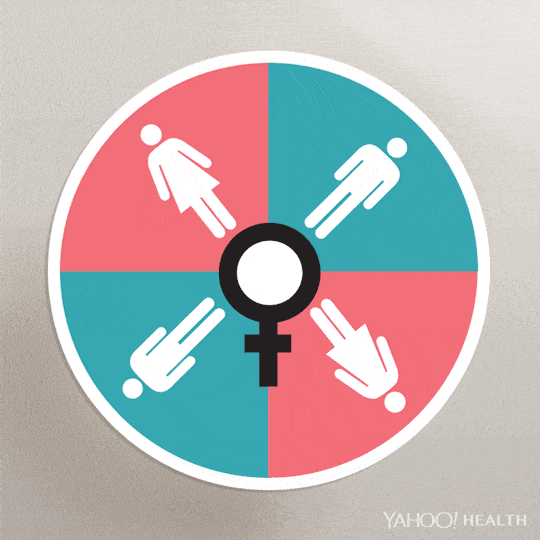A surprising new study shows that sexuality is more likely to change for one sex than the other. (GIF: Hanifa Abdul Hameed for Yahoo Health)
Women’s sexuality is more flexible than that of men, new research suggests.
The study, which followed the sexuality of more than 9,000 people over 14 years, was recently presented at the American Sociological Association’s annual meeting.
For the study, researchers used data from the National Longitudinal Study of Adolescent to Adult Health and tracked 5,018 women and 4,191 men as they moved from adolescence to young adulthood. On average, they were 16 years old in “Wave I” (1994-95), 22 in “Wave III” (2001-02), and 28 in “Wave IV” (2007-08).
In each wave, participants were asked to identify their sexuality, as well as whether they had ever been attracted to a member of the same sex or had experienced same-sex sexual activity. A panel also rated the participants’ attractiveness.
Among the findings: Women were three times more likely to change how they labeled their sexuality between their early and late 20s and more likely to say they were bisexual than men.
Men, on the other hand, were more likely to report being either “100 percent heterosexual” or “100 percent homosexual.”
What’s behind the difference?
“A larger share of women say they’re attracted to both women and men,” study author Elizabeth Aura McClintock, an assistant professor of sociology at the University of Notre Dame, tells Yahoo Health. “If you’re attracted to both sexes, context and opportunity may have more influence on which sex you partner with.”
There was a caveat: Women with more education and those who were rated as more physically attractive were more likely to identify as “100 percent heterosexual” than other women. McClintock says she was surprised by the higher-education finding because being more highly educated “puts you in a more accepting environment.” (She discovered that men with a higher level of education were less likely to identify as “100 percent heterosexual,” as she expected.)
But she points out that women who continue their education and those who are more attractive typically have more opportunities to date men, and for those who are attracted to both men and women, this could influence how they label their sexuality.
McClintock stresses that same-sex sexual interactions aren’t a “second choice” — it simply may be that people who are attracted to both sexes but had good relationships with the opposite sex and were single less often just never explored the option of having a sexual interaction with someone of the same sex.
McClintock isn’t sure why men are less likely to say they’re attracted to both sexes, but she did find that their sexual identity wasn’t influenced by their level of attractiveness.
However, board-certified clinical sexologist Debra Laino tells Yahoo Health that there is a lot of societal pressure on men to identify with either heterosexuality or homosexuality.
“Masculinity has a meaning in our society for men,” she says. There can be fear or feelings of being uncomfortable “with anything outside of traditional masculine gender roles — and many suffer internally because of this.” Laino says many in both the heterosexual and homosexual communities don’t believe bisexuality exists and judge the bisexual community because of it — and men may just be more susceptible to this pressure than women.
McClintock says there is still a lot that we don’t know about sexual identity and why some people choose one label over another. “The societal preference is to have a label for our sexual identity,” she says. “Those labels are kind of silly, but we have them and use them — we’re just not always sure why.”
(YahooHealth)














